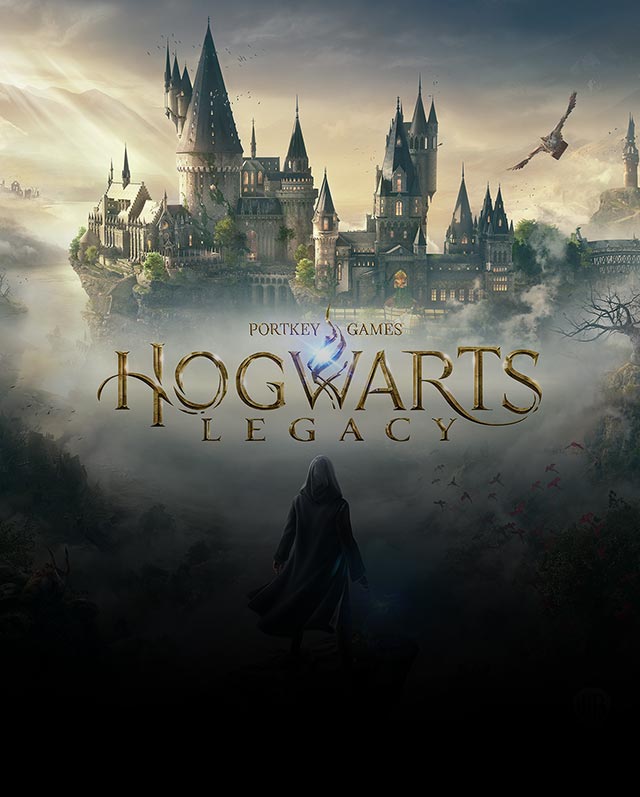The Wizarding World of Harry Potter has remained popular for decades, and is regularly being introduced to voracious new fans of all ages. However, up until recently, the franchise didn’t have much to applaud in the video game department. Warner Bros. Games and their developing partners at Avalanche hoped to change this, though, with the release of the much-anticipated Hogwarts Legacy. A game where we — the player — get to become a student at the iconic school located within that very Wizarding World.
Things begin with character creation, as a quality character creator suite allows us to turn ourselves into aspiring witches and wizards. This is done by selecting a face, a hairstyle and so forth. Thankfully there are good options for different races, including some of the best black hair textures you’ll see in a video game. While my avatar didn’t look much like me — and ended up being a hell of a lot better looking as a result — I was happy with what I chose and didn’t feel like making any changes. Then again, I’m admittedly not one to spend much time creating characters because I’m not that creative, don’t find it fun and would like to just get on with the game. I do my best within a limited frame of time then move on.
The introductory cutscene that follows introduces us to one Professor Fig and another esteemed gentleman who recently lost his wife. Together, the three of us are to fly to Hogwarts in a chariot, but the proverbial shit quickly hits the fan when a dragon unexpectedly attacks, destroying the carriage, killing a man and sending our protagonists speeding towards ground. Lost in the fracas is a peculiar tube of goblin metal, which is said to hold some sort of secret that the one man’s late wife was researching. It’s said that she couldn’t open it.
This accident leaves our student — whom I named after myself — and Professor Fig lost far away from Hogwarts. They decide to hop to it and walk, but quickly find a strange residence where even more incredible things are hidden. This leads to the game’s overarching quest, which has to do with lost magic, Hogwarts history and the evil goblin army that seeks it.
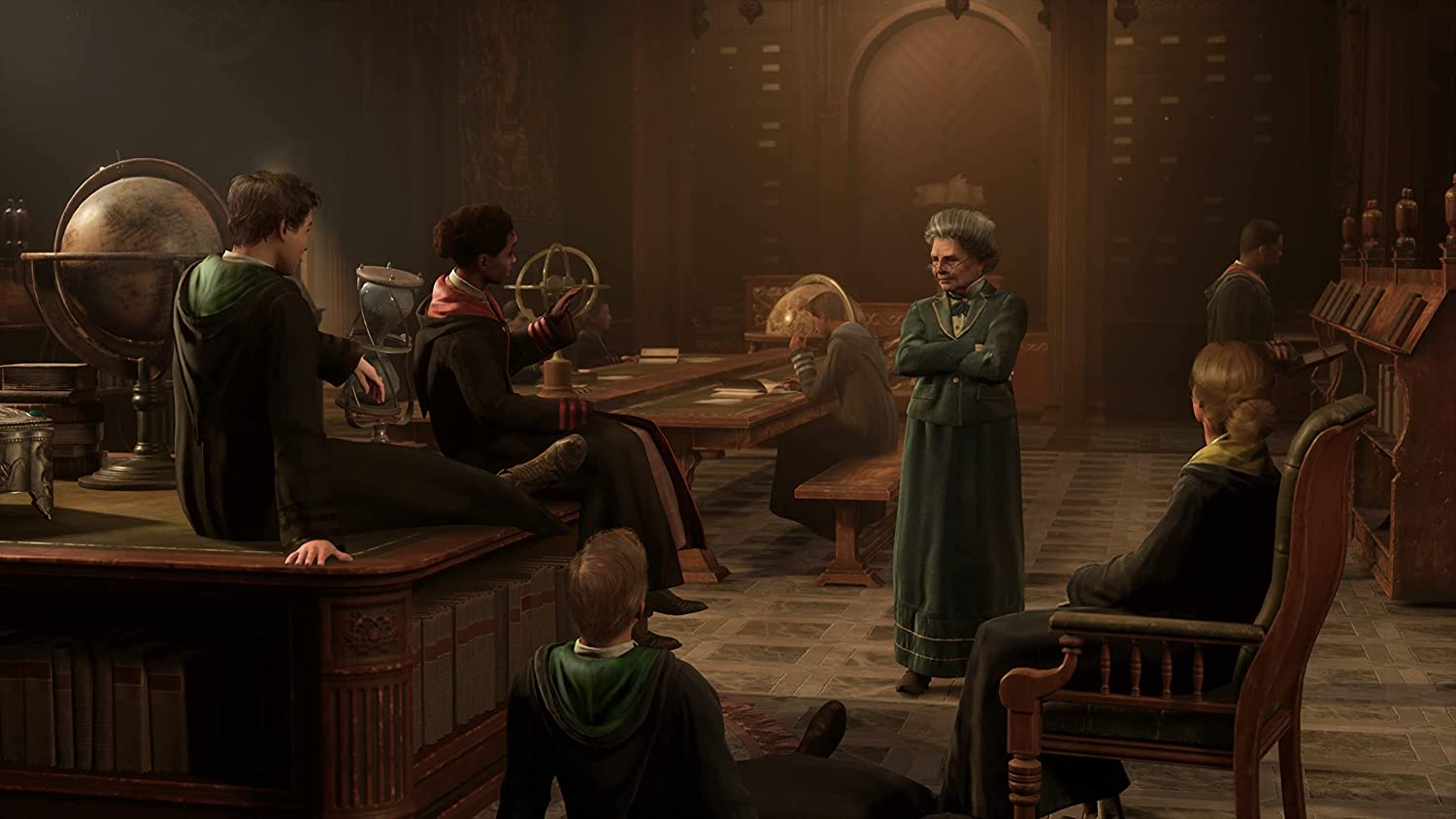
After the opening escapade turned major quest, life at Hogwarts begins anew as you enter the class as a new, fifth year, student. Your rather late enrollment isn’t swept under the rug either. Everyone knows about it, and the professors aren’t going to take it easy on you. In fact, you’ll have to complete extra credit assignments to catch up to the others, and failure to do most of these will prevent you from progressing through the storyline. Granted, they usually have something to do with a necessary spell, helpful plants or potions, or your broom. One must complete these tasks in order to learn the pivotal spells that are taught afterwards, through the game’s strange little minigame. One in which you trace the outline of the spell with the joystick, and press corresponding face buttons (X, Triangle, Square, Circle) to speed yourself up and avoid the red line of doom that’s following close behind.
Be warned, though: Hogwarts Legacy is not the Hogwarts student experience simulator that you may be thinking or even hoping it is. If that’s what you’re after, maybe watch some gameplay or skip this altogether, because it’s an action-RPG at heart. Technically speaking, it’s a Western action-RPG, wherein you play as a wizard and use ranged combat. There are elements of other games to be found here, including open world gameplay and involved quests that are similar to Fable, Kingdoms of Amalur and even Dragon’s Dogma, but they’re all combined into a title that feels like it’s own thing and isn’t afraid to be that.
That isn’t to say that you won’t get to experience life as a student of Hogwarts. You just won’t spend every day attending classes, doing homework, going on excursions and talking to new and unique students. There are classes, but they’re mostly all related to the story and act as tutorials of sorts. You’ll learn how to pot and grow plants, which can then be harvested for potion ingredients; get taught how to care for beasts and make them like you; practice with a broom and become a comfortable flyer and do some astronomy. There’s also a spell-casting class, and maybe one or two others, but you likely get the point. Everything you learn is useful for things later in the game, be it how to make Wiggenweld health potions (which take 15 seconds to brew, as opposed to some others that take a minute or so of waiting), how to care for a beast so that you can harvest its nails or feathers or what have you, or how to duel.
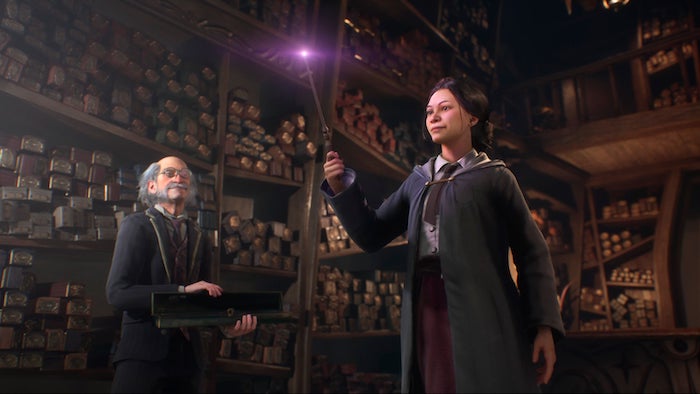
Let’s take a brief tangent to talk about said beasts. You see, it’s here where Hogwarts Legacy kind of reminded me of Pokemon, albeit different. The player’s character is taught how to use a nab-sac to collect wild beasts, then how to bring them to his special room in Hogwarts (which can be customized down to the walls, floor and furniture, and can be used to learn about unknown clothing items, grow plants, brew potions and more). There, a vivarium awaits, allowing some of these creatures to live in harmony in what is essentially another world’s plain. You can visit, brush and feed them there and, in turn, they will provide the aforementioned feathers and other things at timed intervals. These things can be used for better potions, but aren’t all that necessary as I went through most of the game without them.
One of the sub-stories found in Hogwarts Legacy involves poachers who are out in the forbidden forest, and in the other lands this large-scale map encompasses, trapping beasts. Somehow, it’s thought that you trapping and then freeing different types of beasts into your own wonderful vivarium is the answer, so you’ll have some quests related to this. Oddly enough, though, extra beasts that can’t live in your vivarium (due to restrictions on the amount of the same species you possess, for whatever reason) are then sold to a shopkeeper who looks after or sells them. It’s strange to say the least. Then again, at least you’re not capturing and killing them like the many poachers you’ll do wand based battle with throughout the campaign.
There are a number of other side activities to partake in, be they a dueling ring, broom races (which are essentially time trials), opening mathematically closed doors and going around the world looking for pages from your student field guide. The latter is important when it comes to unlocking one of the post-game quests, but I’ve yet to do so even though I did my best to find as many of these pages as possible using the reveal spell. I did a pretty good job, too. Meanwhile, the other post-game quest requires that you be level 34, which I’m most certainly not. I finished the game at 27 or 28 after doing the majority of the side missions, engaging in extracurricular combat, taking down trolls and more. I’m not sure if I’m up to the grind of getting to 34.
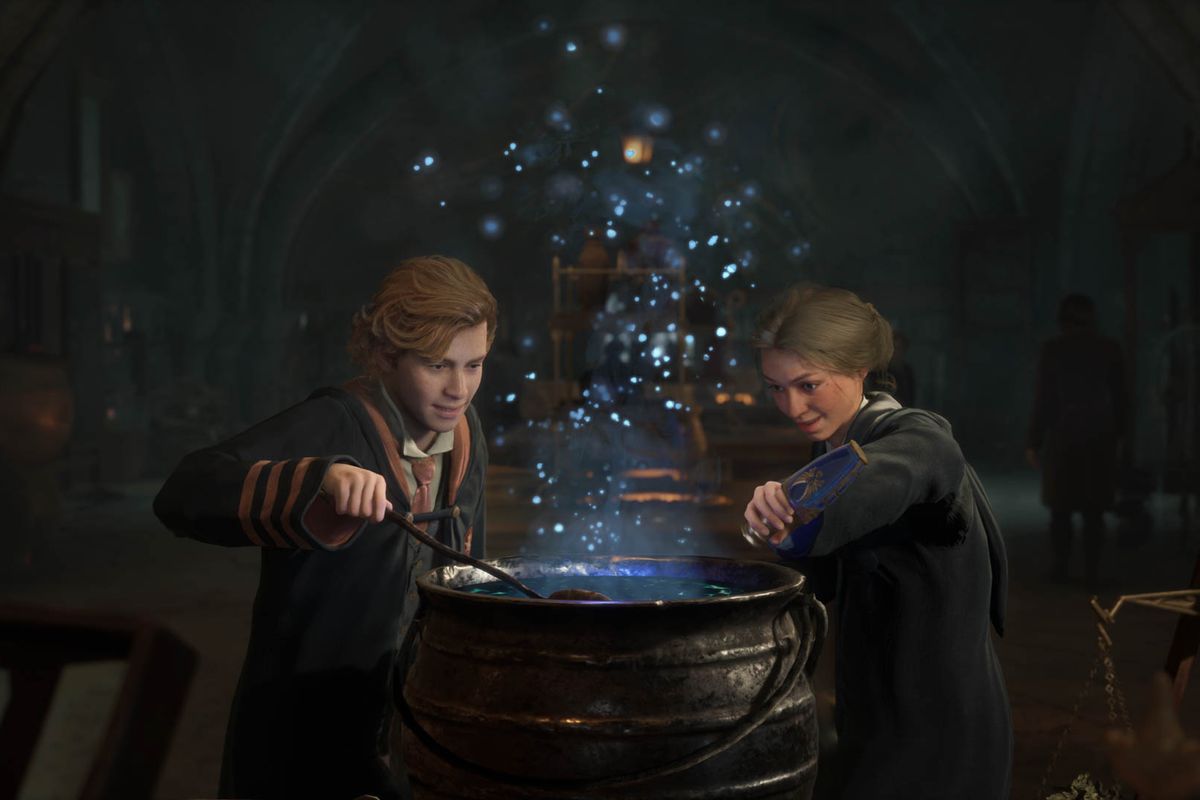
There are a good number of side quests, too. The good news is that there aren’t too many fetch quests, and things are usually more involved like they were in Horizon: Forbidden West, albeit not that great. Engaging in side quests will have you traversing the game map, visiting different caves and villages that are somewhat far from Hogwarts and its local, wizarding village of Hogsmeade, which can be visited at any time. That’s where you shop for potions, wands, brooms/broom upgrades, ingredients, haircuts and more, and where you can also sell your excess gear.
Some of the side quests are related to relationships with other students, like your friends Natty, Poppy and Sebastian, who also go to school in this 1800s version of Hogwarts. Natty’s quests generally involve investigating wrongdoings, Sebastian is a bit of a troublemaker who wants to find a cure for his sister’s curse, and Poppy is anti-poachers meaning she wants help aiding beasts. Completing these quests will improve your relationships with said characters and make them like you more, although it doesn’t seem to matter a whole bunch outside of these branching quest lines. It also doesn’t matter — much — which house you slot into, although I made sure to pick Ravenclaw. Certain clue givers will change, as will one or two quests, but other than that it’s pretty much the same it seems.
Joining these quests are challenging battle arenas, special caves, the aforementioned beast collecting, wells of ancient magic and what are referred to as Merlin trials. These relatively boring experiences involve placing leaves on top of a stone ring, which then triggers a trial like having to light a certain amount of braziers before they go out, destroying a certain number of vases scattered around the castle and so forth. I tried to do as many of these as possible, but eventually gave up. I had some trouble finding well hidden braziers, and would get most of them and then get stuck. I also realized that I was only doing this for extra gear slots and I really didn’t need more. Sure, it was annoying to have to destroy some in order to collect more, but I never had any need for more money. The ones I sold kept me rich enough. More about the gear later, though.
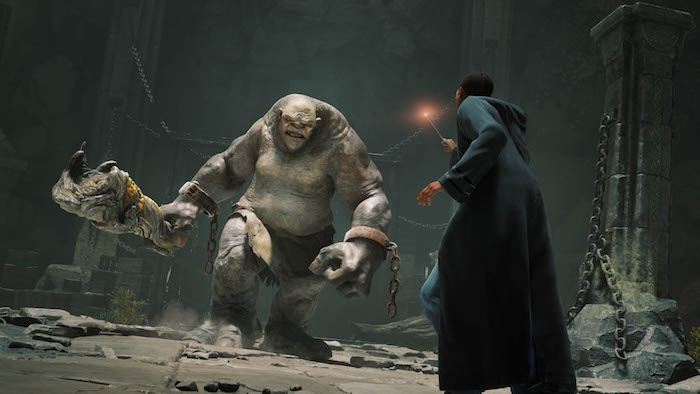
Getting back to the base Hogwarts Legacy experience, it’s imperative that we talk about the combat.
As you travel throughout Hogwarts and its surrounding lands, with their caves, villages and more, you’ll encounter several different kinds of enemies (although the game says there are around 67, because there are ‘unique’ kinds of each). First off, there are the human poachers and gang members, who also carry wands. Then, there are the MANY large spiders you’ll come across throughout Hogwarts Legacy, meaning that the severely arachnophobic may want to steer clear. On top of those, there are wolves, a specific type of sea creature, massive trolls and small goblins, of which you’ll fight many. This lack of variety does make things becomes somewhat repetitive.
Combat is ranged, and is handled exclusively through spells. Everything is handled through a colour coded system, too, wherein different types of spells correlate to different colours; something which becomes important when you need to destroy an enemy’s attempt at blocking damage. Fire spells are obviously red, while push, pull and slam-based ones are purple. Others are either yellow, blue or green, but only red, purple and yellow truly matter. Casting the same coloured spell at an enemy’s bubble blockade will render it useless, opening them back up to attacks.
Whenever an enemy is about to attack you, an icon will appear over your head, providing a chance to block (with your own magical bubble, which comes up when triangle is pressed), or by rolling away and evading, which is what I did 90% of the time. Combat generally isn’t too difficult until the end, when enemies are a few levels ahead of the player and you have to face three or four arenas of them before fighting the final boss. This includes both massive trolls and annoying goblins.
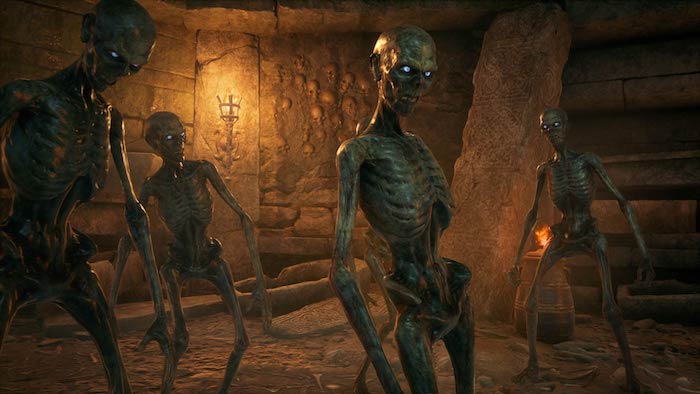
It’s also nice that one’s health replenishes after battle. I would hang on and kill the remaining enemies with limited health, just to avoid using a wiggenweld potion. Why? Well, you can only buy a few from the vendor before they disappear, and in order to craft them you’ll have to plant and look after a good amount of plants. I usually lacked one ingredient, but had many of the others. Thankfully some enemies will drop them in battle. Though, in all honesty, they weren’t really that important or necessary for me until near the end, when things became more challenging.
The spells you’ve learned are all available in a menu, which is easily accessible during combat. You can equip four of them and map them to the face buttons on your controller, then use them by holding R2 and pressing, say, triangle. Then, the spell will take time to come back, but not too much time. It won’t get annoying.
If you want something different, you’ll need to equip it. The good news, though, is that — by spending talent points in the core section — you’ll be able to unlock three other spell sheets. In combat, these can be switched by pressing the trigger button and one of the buttons on the d-pad, allowing you to have four different sets of four spells to throw at enemies. This is helpful, but honestly a bit cumbersome during the heat of battle. Not all players will have this option, either, unless they choose to allocate one to three talent points (which are earned from leveling up after a certain point) to this.
Now, to the gear.
Like most RPGs of this ilk, you’ll find lots of things in chests, including money and gear. The latter is clothing that your character can equip, and you’ll want to keep on top of it. Why? Well, each different piece of clothing — be it eyeglasses, headwear, an outfit, robes, or something else — has its own stats, meaning that every new item you find could be better than what you already have equipped. Not doing so will make the game harder for you, so if you’re someone who likes to pick an outfit and stick with it you’ll be at a loss. Furthermore, most items can be upgraded and enhanced with perks, but you’ll need beast-based consumables for that.
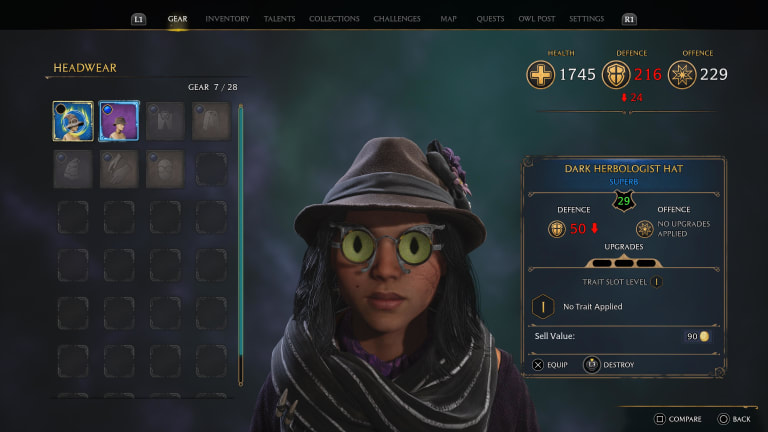
There’s a lot of gear to be found in this game, so expect to see the message saying that you’ve exceeded your limit and can’t collect any more quite often, unless you do many of the Merlin trials. I had to destroy lots of clothing, and sold a good amount, too. My character almost always looked silly, though, because the best things I found usually ended up being goofy hats and what looked like joke glasses, with coloured eyes. I have a feeling that the Harry Potter diehards won’t be a fan of this, but thankfully didn’t care too much about my own avatar’s appearance.
If you’ve read this far and are still wondering whether there’s quidditch, be warned that there is not. The headmaster has cancelled that year’s quidditch season due to a bad injury during the last one. Then again, this isn’t a quidditch game, and its broom controls — which I found rather good — wouldn’t allow for the type of speed and quick turning that the sport would involve. Getting around is made easier, though, by having access to your broom, a winged mount and a ground mount.
Needless to say, Hogwarts Legacy is a true western/action-RPG, as opposed to the Hogwarts life simulator that some fans and non-gamers were hoping for. There are easy and story-based difficulties for those folks, but they’ll still have to deal with all of the quests and RPG elements if they want to play this game through to the end. I can see some giving up because there aren’t a ton of classes to complete, and it’s not a simulator of the student lifestyle that the books — which I’ve yet to read, but hope to soon — present. It’s worth it, though, because this is a good game.
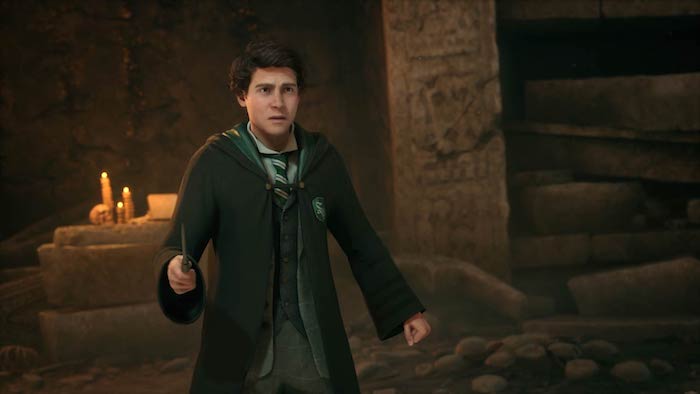
The story found within isn’t the absolute best, and may have been better if it didn’t involve goblins, but it’s still above average. The world building is excellent. The gameplay is really good, and does a nice job of blending action-RPG mechanics with light platforming and puzzle solving. Plus, there’s a lot of secondary content to keep people busy for maybe 40 hours. I did a thorough playthrough and completed things at what the game said was 22 hours, but as I mentioned above there are quests that won’t unlock until I’m level 34 or have found most of the many pages of the field guide. Both would take a lot of time. So, too, would finding all of the flying book pages, following all of the special keys to their locked chests, opening all of the seeing eye chests and figuring out the arithmetic to open the mathematically sealed doors. Regularly locked doors can be opened using a spell, which turns into a minigame wherein you must rotate gears until they start moving. However, in order to unlock level 2 and level 3 locks you’ll need to do some extracurriculars.
Now, after all of that important stuff, let’s talk about the presentation.
It goes without saying that almost everyone who plays this game will do so hoping for an optimal Hogwarts experience, in what is the best video game version of the iconic castle. Well, that dream will come true for fans of the source material, because Hogwarts has been painstakingly recreated and it’s amazing. Although it’s hard to read on a map, you can travel to different areas using floo flames and can also follow a guided path to your next objective. As you do so, or simply explore, you’ll see a wonderful location that was designed with love. Although I’ve only seen the first three movies, I was thoroughly impressed with how well Hogwarts was created from what I remembered of it, and couldn’t believe the attention to detail when I first started playing. Bushes, statues, plaques and paintings move, battle and speak. Students talk amongst themselves as you walk by. There are also lots of hidden areas to find and explore, mostly through side quests. Plus, the Great Hall and staircase have been wonderfully recreated. Although it’s kind of a silly term to use for such a game, the Hogwarts school found in Hogwarts Legacy is truly magical. It’s amazingly done.
Hell, the seasons change and so does Hogwarts. You’ll start in summer, then transition to fall (which is full of Jack-o-lanterns and growing pumpkins, including many indoor decorations), then on to winter. The pumpkins and lettuce still grow, but the land is snowy and Hogwarts becomes full of Christmas decorations. It’s really quite something, and not half-assed at all.
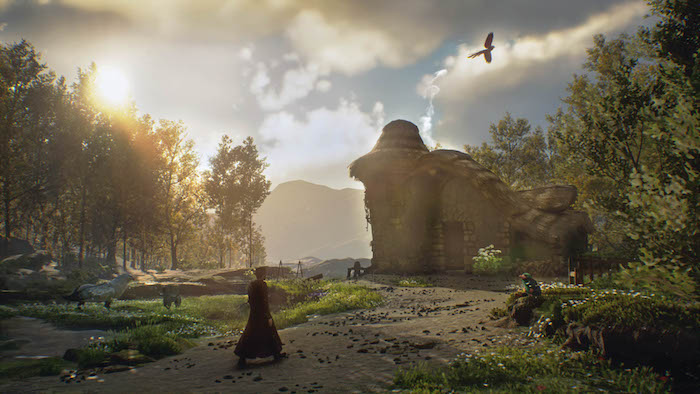
What’s also very impressive — at least on current-gen hardware like the PlayStation 5 — is the fact that you can go from one side of the castle to the other rather quickly, so long as you run. There are almost no loading screens to be found here, but the game will briefly pause you at a door to another area if it needs to (quickly) load that section in. The delay is brief, though, and hardly bothersome. In fact, it didn’t bother me at all. I understood how much it was doing behind-the-scenes, and knew how impressive this all was. Needing to briefly load for a second doesn’t bother me at all. I grew up with very lengthy load times, and would’ve even accepted those if need be. Then again, I’m not too particular about this type of thing. Loading screens don’t bug me much.
It’s also important to mention that this game has some of the best and most detailed faces I’ve ever seen, especially when it comes to the main characters. I was blown away upon starting the campaign, and seeing how the major players looked. The faces are incredible.
Hogwarts Legacy also sounds incredible, thanks to really good writing, a fantastic orchestral score and absolutely wonderful voice acting. It’s all very believable, and the incredible visuals certainly help. You can toggle between performance and visual fidelity modes, or more balanced options, including one that favours FPS in its ‘balance.’ I tried both of those, because our display allowed for them, and was thoroughly impressed. There was hardly ever a hiccup, with only the odd occurrence of brief frame rate drops. Brief is the word, too. They were rare and unobtrusive.
Overall, this is a very good game, and one that pays a ton of fan service. Those who love the Harry Potter universe are sure to be impressed by Hogwarts Legacy, even if they only buy it to go to some classes and wander throughout Hogwarts. Avalanche has truly put a lot of blood, sweat and tears into what is a product to be proud of, and one that I’m glad I gave a chance to. I’d wondered if I would like it, because I’m not a big fan of the source material and struggle with period pieces. It’s not perfect, but it’s very good overall.
This review is based on the PlayStation 5 version of the game, which we were provided with.

